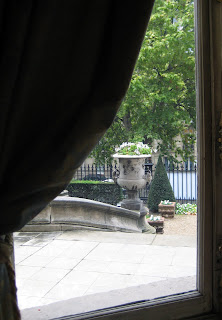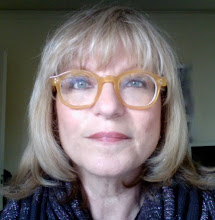Along the Champs Elysées for the last few weeks has been an exhibit of Vogue covers, celebrating 79 years of French Vogue. (Why 79 years? I assume they're not feeling very confident of reaching 80 in the current economic climate, where magazines have been dropping like flies). This is a part of Paris I usually avoid, but I wanted to see this, so we took the métro up to Champs Elysées-Clemenceau station late yesterday afternoon.
The images are ranged along the sidewalk on the south side of the Champs and attract the attention of tourists and Parisians alike. I can't count the number of women we saw posing in a model-like posture in front of one or another of the covers. They're not arranged chronologically, a good decision in my opinion, and can be viewed walking in either direction. To see them all you presumably are supposed to walk up and down the avenue, but most of us just looked at the front and back of each panel in passing.
The images are ranged along the sidewalk on the south side of the Champs and attract the attention of tourists and Parisians alike. I can't count the number of women we saw posing in a model-like posture in front of one or another of the covers. They're not arranged chronologically, a good decision in my opinion, and can be viewed walking in either direction. To see them all you presumably are supposed to walk up and down the avenue, but most of us just looked at the front and back of each panel in passing.
The early ones are drawings, sometimes stylized, sometimes whimsical. Many, not to say most, have some symbol of Paris in them: the Eiffel Tower, the Arc de Triomphe, the Concorde obelisk, the Vendôme column.
The magazine didn't publish during the Occupation and one of the earliest covers after the Liberation is this one:
Notice the American flag flying next to the tricolor over the Hotel Crillon in Place de la Concorde, and the men in uniform in the lower right corner, not to mention the paucity of vehicles in the Place.
The post war era brought photography to Vogue covers (note the Parisian background still) and an interesting tradition of asking famous artists to act as editor for an occasional edition of the magazine. There's Joan Miro,
David Hockney,
and this incredible Salvador Dali, bringing Marilyn Monroe and Mao Tse-Tung together in a single image.
Kate Moss and the other supermodels we're familiar with are represented, but I was drawn to all the iconic faces, Twiggy, the personification of the Swinging '60s, the eighteen-year-old Catherine Deneuve, just starting the career that would make her the living symbol of the Frenchwoman, Brigitte Bardot, no longer the young sex kitten but still coverworthy at the end of her movie career.
Audrey Hepburn's incredible neck and unforgetable style stuck out even among all these beauties, attracting more passerby attention than any other, it seemed to me.

The exhibition comes down this weekend, so it was our last opportunity to see it and I'm glad we went., although we had to squeeze it in between packing and cleaning.
Tomorrow we move to our next apartment.




























































